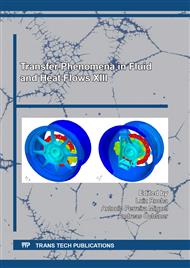[1]
P. Arora et al., Fatigue crack growth behavior in pipes and elbows of carbon steel and stainless steel materials, Procedia Eng. 55 (2013) 703–709.
DOI: 10.1016/j.proeng.2013.03.318
Google Scholar
[2]
X. Schuler and K. H. Herter, Thermal Fatigue due to Stratification and Thermal Shock Loading of Piping, 30th MPA-Seminar conjunction with 9th Ger. Semin. (2004) [Online]. Available: http://www.iaea.org/inis/collection/NCLCollectionStore/_Public/36/036/36036665.pdf.
Google Scholar
[3]
E. Paffumi, K. Nilsson, and N. G. Taylor, Simulation of thermal fatigue damage in a 316L model pipe component Japan Society of Mechanical Engineers, Int. J. Press. Vessel. Pip. 85 11 (2008) 798–813.
DOI: 10.1016/j.ijpvp.2008.06.002
Google Scholar
[4]
K. Nilsson, F. Dolci, T. Seldis, S. Ripplinger, A. Grah, and I. Simonovski, Assessment of Thermal Fatigue Life for 316L and P91 Pipe Components at Elevated Temperatures, Eng. Fract. Mech. (2016).
DOI: 10.1016/j.engfracmech.2016.09.006
Google Scholar
[5]
K. Evon, T. Gilman, and M. Walter, Fatigue monitoring of BWR feedwater nozzles, Proceedings of the ASME Pressure and Piping Conference. (2013) 1–6.
DOI: 10.1115/pvp2013-98032
Google Scholar
[6]
M. F. Harun, R. Mohammad, and A. Kotousov, Low cycle fatigue behavior of elbows with local wall thinning, Metals (Basel). 10 (2020) 1–9.
DOI: 10.3390/met10020260
Google Scholar
[7]
F. A. Simonen et al., Evaluation of environmental effects on fatigue life of piping, Nucl. Eng. Des. 208 (2001) 143–165.
Google Scholar
[8]
ASME Boiler and Pressure Vessel Code, Section III, Division 1 — Appendices Rules for Construction of Nuclear Facility Components, 2010th ed. ASME International, (2010).
DOI: 10.2172/1471711
Google Scholar
[9]
W. J. O. Donnell, W. J. O. Donnell, and T. P. O. Donnell, Proposed new fatigue design curves for austenitic stainless, J. Press. Vessel Technol. Trans. ASME. (2005) 1–24.
Google Scholar
[10]
W. J. O'Donnell and T. P. O'Donnell, Proposed new fatigue design curves for carbon and low-alloy steels in high temperature water, J. Press. Vessel Technol. Trans. ASME. 131 (2009) 1–10.
DOI: 10.1115/1.3006896
Google Scholar
[11]
O. K. Chopra, Development of fatigue design curve for austenitic stainless steels in LWR environments: A Review, Proceedings of PVP. (2002) 1-14.
DOI: 10.1115/pvp2002-1229
Google Scholar
[12]
O. K. Chopra, W. F. Michaud, and W. J. Shack, Fatigue of carbon and low-alloy steels in LWR environments, Proceedings of water Reactor Safety Meeting. (1993).
DOI: 10.2172/10114321
Google Scholar
[13]
O. K. Chopra and W. J. Shack, Methods for incorporating effects of LWR coolant environment into ASME code fatigue evaluations, Am. Soc. Mech. Eng. Press. Vessel. Pip. Div. PVP. 386 (1999) 171–181.
Google Scholar
[14]
O. K. Chopra and G. L. Stevens, Effect of LWR water environments on the fatigue life of reactor materials, NUREG/CR-6909,Rev.1; Final Report, Washington, DC, (2018).
Google Scholar
[15]
M. Higuchi and K. Iida, Fatigue strength correction factors for carbon and low-alloy steels in oxygen-containing high-temperature water, Nucl. Eng. Des. 129 (1991) 293–306.
DOI: 10.1016/0029-5493(91)90138-8
Google Scholar
[16]
M. Higuchi, Revised proposal of fatigue life correction factor Fen for carbon and low alloy steels in LWR water environments, J. Press. Vessel Technol. Trans. ASME. 126 (2004) 438–444.
DOI: 10.1115/1.1767860
Google Scholar
[17]
K. Sakaguchi, S. Suzuki, H. Kanasaki, Y. Nomura, K. Tsutsumi, and M. Higuchi, Effect of factors on fatigue life in PWR water environment, Am. Soc. Mech. Eng. Press. Vessel. Pip. Div. PVP. (2006) 1–9.
DOI: 10.1115/pvp2006-icpvt-11-93217
Google Scholar
[18]
ASME Boiler and Pressure Vessel Code, Rules for Construction of Nuclear Facility Components III Division 1-Subsection NB, Class 1 Components. (2010).
DOI: 10.1115/1.802694.ch6
Google Scholar
[19]
R. A. Ibrahim, Handbook of structural life assessment, first ed., John Wiley & Sons Ltd, Hoboken, NJ, (2017).
Google Scholar
[20]
G. L. Stevens, Environmentally Assisted Fatigue Screening Methods (Revision 1), EPRI, Palo Alto, CA, (2020).
Google Scholar


